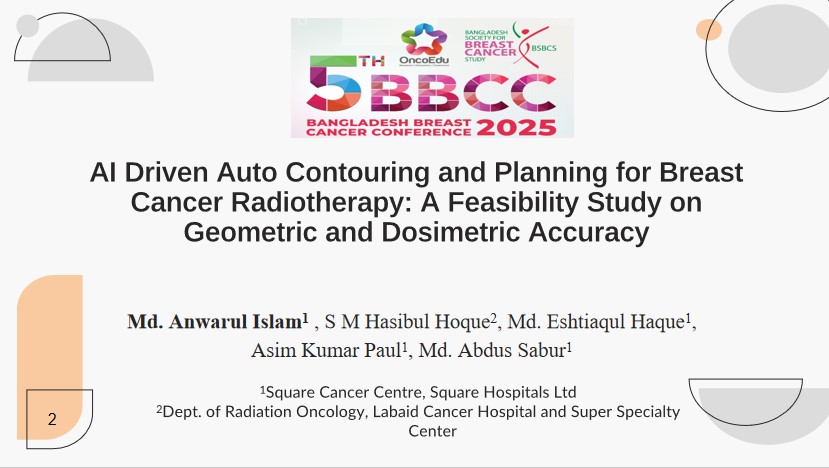AI Driven Auto Contouring and Planning for Breast Cancer Radiotherapy: A Feasibility Study on Geometric and Dosimetric Accuracy.
Authors: Md. Anwarul Islam1, S M Hasibul Hoque2, Md. Eshtiaqul Haque1, Asim Kumar Paul1, Md. Abdus Sabur1
Institution: 1Square Cancer Centre, Square Hospitals Ltd 2Dept. of Radiation Oncology, Labaid Cancer Hospital and Super Speciality Center
Introduction
The integration of artificial intelligence (AI)-based autocontouring and autoplanning into the radiotherapy (RT) workflow requires review and modification by a radiation oncologist before treatment planning. This process aims to enhance dosimetric accuracy while reducing interobserver variability and contouring time. This study evaluates the performance of a commercial AI-based autocontouring and autoplanning system in RT, assessing both geometric accuracy and the influence of human-reviewed AI-generated contours on optimized dose distribution and treatment plan quality.
Methods
A commercial AI-based autocontouring (Auto Contour, v2.5) and autoplanning (EZFluence v2.4.4) system from RAD formation were applied to a retrospective dataset of 20 patients treated with breast cancer radiotherapy. Human-generated contours were compared against AI-assisted human-reviewed contours using geometric evaluation metrics, including the Dice Similarity Coefficient (DSC), Hausdorff Distance (HD), and Relative Volume Difference (RVD). Dosimetric analyses were conducted using parameters such as mean dose (Dmean), near-maximum dose (D0.03cc), and normalized plan quality metrics to assess dose distribution differences between treatment plans generated from AI-assisted contours and those based on manual delineation. Additionally, the reduction in contouring and planning time achieved through automated tools was evaluated.
Results
In breast cancer cases, the agreement between AI-generated and manually contoured structures exhibited substantial variability. The spinal cord and thyroid demonstrated the highest differences, with a Dice similarity coefficient (DSC) of <0.5 and a 61% volume difference, while the contralateral breast showed a 20% volume difference. Dosimetric differences between AI-assisted and manually contoured plans were not statistically significant for most organs at risk (OARs); however, the greatest variation in dose metrics (Dmax, Dmean, and D0.03cc) was observed for the contralateral breast. Minor dose differences were noted for the heart and spinal cord. The average deviation in plan quality metrics for breast cancer cases was 0.7%. Implementation of AI-assisted contouring and planning resulted in a 65% and 73 % reduction in contouring and planning time respectively.
Conclusion
The integration of an autocontouring and autoplanning system with human review significantly decreases the time required for the radiotherapy (RT) workflow while maintaining dose distribution accuracy and plan quality.
